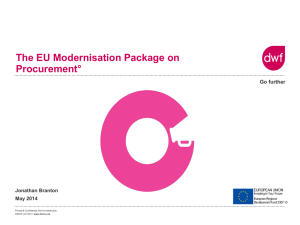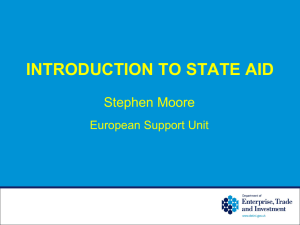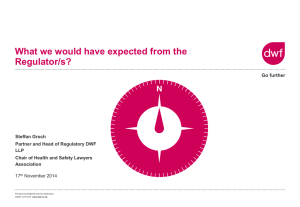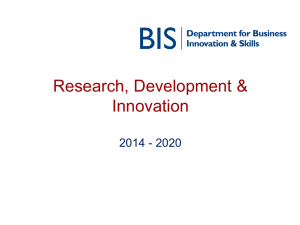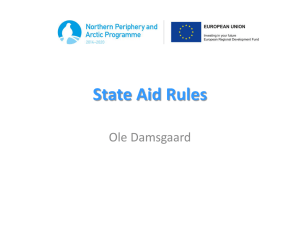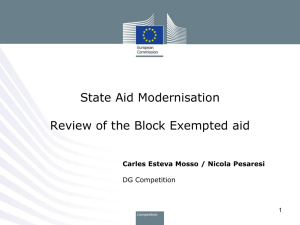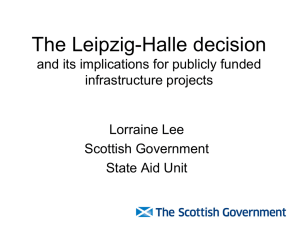State Aid Slides JM 16.05.14
advertisement
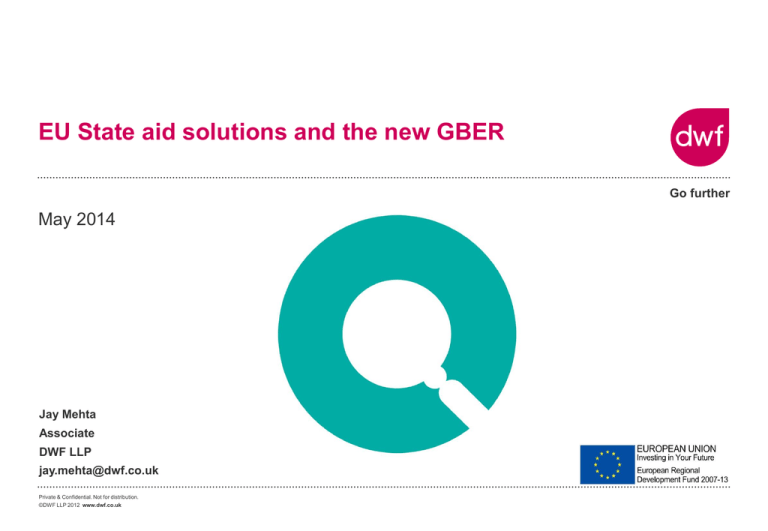
EU State aid solutions and the new GBER Go further May 2014 Jay Mehta Associate DWF LLP jay.mehta@dwf.co.uk Private & Confidential. Not for distribution. ©DWF LLP 2012 www.dwf.co.uk Basics of State aid & Funding applications • Good State aid solution does not make a funding application necessarily successful • Bad or no State aid solution usually does ruin a funding application • Solutions can be same across funding streams – eg. RGF/AMSCI – or ERDF/Employer Ownership/Growing Places/RGF programmes etc. • Best solution - no State aid at all – see new draft notice on the notion of State aid (January 2014) • Obtaining approval when State aid is present – need European Commission approval: – Block Exemption (General Block Exemption Regulation 800/2008 “GBER” or De Minimis Regulation 1407/2013 – see following slides); or – Part of notified national framework scheme (eg. Derelict Land, HERS); or – Individual Notification • Sanctions and enforcement – why it matters? Private & Confidential. Not for distribution. ©DWF LLP 2012 www.dwf.co.uk 2 How to spot a State aid Identifying a State aid is not always straight-forward. Companies receiving aid without prior approval risk having to repay it with interest. The brief flow chart below addresses the questions, which must be asked, when first assessing a potential State aid. It is not a substitute for legal advice, which must be applied subjectively to each individual. 1. ECONOMIC ADVANTAGE: Does the aid confer a financial advantage, in any form whatsoever, on the business in a gratuitous form (ie. where the aid includes an element of gift rather than being a normal commercial contract available on the market? YES 2. TRANSFER OF STATE RESOURCES: Does the aid involve a transfer of state resources (including ERDF, Lottery, ROCs/FiTs, Tax rebates and exemptions, loans and asset transfers at below market values). YES 3. SELECTIVITY: Is the aid selective (i.e. only available to a limited number of enterprises or specific group of enterprises). This distinguishes State aid from general measures which affect all (like a public road or a general tax exemption for the benefit of all). YES 4. EFFECT ON COMPETITION AND TRADE: State aid must have a potential effect on competition and trade between Member States. It is sufficient to show that the beneficiary is involved in an economic activity in which there is trade between Member States. YES 5. IS THE AID COVERED BY A BLOCK EXEMPTION REGULATION: If the aid is covered by GBER or the De Minimis Regulation, it will be exempt from notification requirements provided all relevant terms are respected. NO 6. HAS THE AID ALREADY BEEN CLEARED BY THE COMMISSION AS PART OF AN EXISTING NATIONAL AID SCHEME? For example Land Remediation Scheme. NO 7. THE AID MAY NEED TO BE INDIVIDUALLY NOTIFIED TO THE EUROPEAN COMMISSION FOR APPROVAL. Private & Confidential. Not for distribution. ©DWF LLP 2012 www.dwf.co.uk NOTIFY What is not State aid? • Some common examples: – Sale, lease or purchase of property at open market value – Funding non-undertakings carrying on non-economic activity – Services of general economic interest (Altmark) - procuring a public service via open competitive process – Infrastructure of benefit to the general public (non commercially exploitable – but see also Leipzig Halle) – Market investor behaviour – Flow throughs (German Incubators) If no aid, aid management techniques not required Private & Confidential. Not for distribution. ©DWF LLP 2012 www.dwf.co.uk Managing State aid • Render aid “compatible with the Common Market” • Block Exemption Regulations (de minimis, GBER) – GBER includes SMEs, training, employment, regional, environmental, R&D, risk capital and female entrepreneurs – GBER extended to 30-6-2014, version 2 to be published June1 effect July1 • Individual notification of national schemes – eg. Derelict Land, Housing Gap Funding, Historic Environment Regeneration etc. • Individual notification to the European Commission followed by approval decisions – Stick to one of Commission’s series of guidelines if possible – Phases I (2 months?) and II (18-20 months?) Private & Confidential. Not for distribution. ©DWF LLP 2012 www.dwf.co.uk GBER issues - general • Eligibility – Project – eg. is it a genuine research project or simply an investment project? – Applicant – insolvent or for regional investment aid purposes in an excluded sector? – Costs – are the costs as set out in relevant GBER provision eg. personnel, tangible and intangible assets, contract research, direct expenses/overheads for R&D? • Intensity – Different aid intensities per type of aid, eg. R&D experimental development 25% and industrial research 50%, or training - specific (25%) and general (60%) – uplifts available for SMEs of 10% for medium and 20% small enterprises – R&D uplifts also available for genuine collaborations/dissemination activity (15%) • Incentive effect – Basic (all applicants & all programmes) – don’t start the project before filing the application! – Large applicants – evidence to demonstrate change in project activity Private & Confidential. Not for distribution. ©DWF LLP 2012 www.dwf.co.uk GBER basics (2) – other points • Notification thresholds – Need to notify individually to European Commission and get approval before proceeding if aid intensity/amount too high, even if other GBER requirements met – Translate to sterling at European Commission published exchange rate for the month of the unconditional contract – Applies per applicant per project – – – – Research & Development Industrial research (EUR 10m) Research & Development Experimental development (EUR 7.5m) Training (EUR 2m) Regional Investment aid – costs and aid amount restrictions but less likely to apply for AMSCI where most projects proceed under R&D • Cumulation rules – Watch out where several aid applications are made by one undertaking (eg. grants & R&D tax credits, investment aid and RoCs)! Private & Confidential. Not for distribution. ©DWF LLP 2012 www.dwf.co.uk GBER specifics Regional investment and employment aid • Regional aid limited to 75% of maximum amount a project with EUR100m of eligible costs would allow (eg. EUR11.25m in 15% area). • Regionally assisted areas: http://stats1.bis.gov.uk/regional-aa/aa2007.asp • Regional aid eligible costs are investment in tangible and intangible assets, or wage costs (maintained at least 5 years/3 years if SME) Training aid • Training aid given at 25% or 60% - specific or general training (+ uplift for SMEs) • Eligible training costs are trainer and training costs, plus wage costs of personnel to be trained (while training) • Maximum EUR 2m per undertaking per training project Private & Confidential. Not for distribution. ©DWF LLP 2012 www.dwf.co.uk GBER specifics - continued Research and Development aid • Not just routine improvements to products and processes • Maximum aid at 25%,50% or 100% - experimental development, industrial research or fundamental research • Eligible costs are personnel costs, instruments and equipment, contractual research and IPRs, land & buildings and other directly related costs to R&D project • Maximum amounts per undertaking per R&D project EUR 7.5m, 10m, 15m SME investment and employment aid • Maximum amount EUR 7.5m per undertaking per investment project • Aid limited to 10% (medium SME) or 20% (small SME) • See Annex I GBER for SME definitions Private & Confidential. Not for distribution. ©DWF LLP 2012 www.dwf.co.uk New GBER (1) – Some overall changes proposed • Basic incentive effect (SMEs and large undertakings) – definition of application for aid • Additional incentive effect (large undertakings only) - in scheme aid may not have additional incentive effect requirements. • More detailed provisions for repayable advances which are now recognised in GBER outside of R&D. Repayable advances attract 10% higher maximum intensity limits across GBER. • Procedurally there are more detailed submission forms, there is now an express right to veto GBER application by the Commission ex post and there are clawback provisions for net revenues generated in some cases where investment and operating aid are allowed. • Ad hoc (out of scheme) aid can be granted to large enterprises outside of a GBER scheme. • Cumulation restrictions with risk capital have been removed. Private & Confidential. Not for distribution. ©DWF LLP 2012 www.dwf.co.uk New GBER summary (2) – Some important new aids Aid Intensity/description Notification threshold R&D Infrastructure 50% of Construction or upgrade of facilities provided access to several users at market price E 20m per infrastructure Innovation Clusters 50% investment and operating E 7.5m per cluster costs for entity running the cluster provided access to several users at cost or market price Broadband infrastructure 100% of installation works E 70m cost per project Regional aid for urban development projects 70% of project costs of JESSICA type projects (urban development funds – compliance with ERDF?) E 20m per project Sports & Multifunctional recreation infrastructure 75% of capital and incremental running costs E 15m aid or costs over E 50m per project Cultural & Heritage conservation 100% of refurbishment/new build and asset need not be listed. Also operating costs are eligible E 100m investment aid per project; E 50m operating aid per undertaking per annum Private & Confidential. Not for distribution. ©DWF LLP 2012 www.dwf.co.uk New GBER summary (3) - Some changes R&D & Training • R&D • Training aid • Notification thresholds doubled (E 20m for industrial research and E 15m for experimental development) • No separation between general and specific training • Dissemination bonus now applicable to experimental development • Flat 50% intensity and E 7.5m threshold for feasibility studies • All training has an aid intensity of 50% • Personnel costs and general indirect costs only eligible for SMEs • Research Organisation need not be “not for profit” • Personnel/overheads no longer restricted to 50% of costs and profit re-investment no longer necessary • Aid for process and organisational innovation (15% • Maximum intervention rate now 70% including bonuses (SME, for large companies and 50% SMEs) up to a disadvantaged and disabled threshold of E 7.5m per undertaking per project. workers) Eligible costs same as R&D. Large enterprises can only claim if they collaborate with SMEs who bear at least 30% of the eligible costs Private & Confidential. Not for distribution. ©DWF LLP 2012 www.dwf.co.uk New GBER summary (4) – Some changes Regional/SME • Regional aid • SME aid • Separate incentive effect requirement • No SME consultancy aid any more • Large enterprises must demonstrate “new economic activities” in tier 2 areas • Innovation aid for SMEs (50% of costs of personnel, innovation advisory and support services and IP (E 5m per SME per project) • SME bonuses for regional investment aid not expressed in body of regulation – only in notification form! • New Regional Aid Map and guidelines to come out at same time. • New Regional Aid Map (draft) now covers areas in Cheshire but basic intensity drops to 10% (20% for Medium sized enterprises and 30% for Small enterprises) Private & Confidential. Not for distribution. ©DWF LLP 2012 www.dwf.co.uk • Start up aid schemes for small innovative enterprises comprising risk finance and grant • Aid for SME trading markets New GBER summary (5) – Some change Environment • Some Changes in existing aid measures • Eligible regional aid investments may be new installations only in some cases • 10 year limit for tax reductions removed • New intensities for anticipating community standards depending on how early they are anticipated • Some New aids • Remediation of contaminated sites. Similar to (UK) land remediation scheme but only restricted to depollution. 100% intensity minus increase in site values • Energy efficient projects - Green deal style loan (E 10m max) to a fund to be passed on to building owners for retrofits. At least 30% private investment needed for fund • Operating aid for small scale installations – 100% of difference between market price and “levelised cost” (Net Present Cost of connection to the grid). Private & Confidential. Not for distribution. ©DWF LLP 2012 www.dwf.co.uk New GBER summary (6) Current draft of the proposed new GBER which will come into effect from 1st July 2014 (subject to change) Rates in draft of proposed new GBER Capital Investment Aid Assisted ‘C’ Area (tier 2) % NonAssisted Area % Small 30 20 Medium 20 10 Large 10 0 Business Size: Training R&D Industrial R&D % Experimental R&D % 70 70 (*80) 45 (*60) 60 60 (*75) 35 (*50) 50 50 (*65) 25 (*40) For reference and comparison, the current rates are below: Current rates Capital Investment Aid Training R&D Assisted ‘C’ Area (tier 2) % Non-Assisted Area % General Training % Specialist Training % Industrial R&D % Experimental R&D % Small 35 20 80 45 70 (*80) 45 (*60) Medium 25 10 70 35 60 (*75) 35 (*50) Large 15 0 60 25 50 (*65) 25 (*40) Business Size: Private & Confidential. Not for distribution. ©DWF LLP 2012 www.dwf.co.uk Conclusions on State aid • Aid there to be taken advantage of, new GBER should offer additional flexibilities • Risk assessments – law, practicalities and politics • Interaction with other areas (procurement, ERDF) • State aid problems may be serious if ignored • State aid issues may usually be avoided by attention to detail • Unwillingness to consider may lose inward investment opportunities to other markets • State aid can be steered through by individual notification if absolutely necessary • State aid can rectify market failures and make things possible that otherwise would not happen Private & Confidential. Not for distribution. ©DWF LLP 2012 www.dwf.co.uk Go further° DWF is the business law firm with industry insight. Our legal experts combine real commercial understanding and deep sector knowledge to help clients anticipate issues, create opportunities and get the outcomes they need. We’ll deliver the results that help you go in the right direction – wherever you are. Birmingham +44 (0)121 572 8500 Glasgow +44 (0)141 228 8000 London +44 (0)207 645 9500 Preston +44 (0)177 255 6677 Coventry +44 (0)247 622 8734 Leeds +44 (0)113 261 6000 Manchester +44 (0)161 603 5000 Teesside +44 (0)164 262 3400 Edinburgh +44 (0)131 226 5541 Liverpool +44 (0)151 907 3000 Newcastle +44 (0)191 233 9700 ©DWF LLP 2012 DWF LLP is a limited partnership registered in England and Wales with registered number OC328794. The content of the Regulatory and Licensing Insert does not constitute legal advice and should not be relied on as such. Specific advice should be sought about your specific circumstances. www.dwf.co.uk

